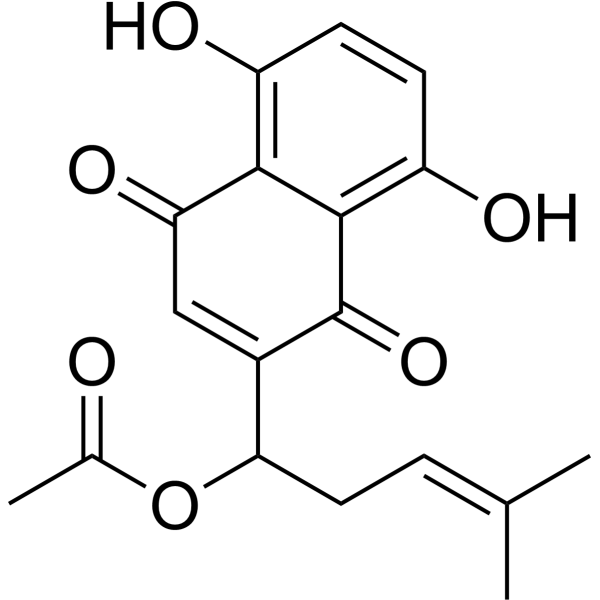
Acetylshikonin
CAS No. 54984-93-9
Acetylshikonin( —— )
Catalog No. M31145 CAS No. 54984-93-9
Acetylshikonin can effectively inhibit tumor cells, it can be used to treat hepatocellular carcinoma cells expressing hepatitis B virus X protein (HBX) by inducing ER stress .
Purity : >98% (HPLC)
 COA
COA
 Datasheet
Datasheet
 HNMR
HNMR
 HPLC
HPLC
 MSDS
MSDS
 Handing Instructions
Handing Instructions
| Size | Price / USD | Stock | Quantity |
| 50MG | Get Quote | In Stock |


|
| 100MG | Get Quote | In Stock |


|
Biological Information
-
Product NameAcetylshikonin
-
NoteResearch use only, not for human use.
-
Brief DescriptionAcetylshikonin can effectively inhibit tumor cells, it can be used to treat hepatocellular carcinoma cells expressing hepatitis B virus X protein (HBX) by inducing ER stress .
-
DescriptionAcetylshikonin can effectively inhibit tumor cells, it can be used to treat hepatocellular carcinoma cells expressing hepatitis B virus X protein (HBX) by inducing ER stress , an oncoprotein from hepatitis B virus. Acetylshikonin inhibits the production of eicosanoid, is due to the attenuation of cytosolic phospholipase A(2) membrane recruitment via the decrease in [Ca(2+)](i) and to the blockade of cyclooxygenase and 5-lipoxygenase activity.
-
In Vitro——
-
In Vivo——
-
Synonyms——
-
PathwayOthers
-
TargetOther Targets
-
Recptor——
-
Research Area——
-
Indication——
Chemical Information
-
CAS Number54984-93-9
-
Formula Weight330.33
-
Molecular FormulaC18H18O6
-
Purity>98% (HPLC)
-
Solubility——
-
SMILES——
-
Chemical Name——
Shipping & Storage Information
-
Storage(-20℃)
-
ShippingWith Ice Pack
-
Stability≥ 2 years
Reference
molnova catalog



related products
-
Sphenanlignan
Sphenanlignan is a natural product of Schisandra, Schisandraceae. Sphenanlignan can be used as a reference standard.
-
Propargyl-PEG12-brom...
Propargyl-PEG12-bromide is a PEG-based PROTAC linker used to synthesize PROTACs.
-
HBC620
HBC620 shows brightly fluoresced in the Pepper bound state and can be visualize RNA dynamics in live cells.?HBC620 is a HBC-like fluorophore.



 Cart
Cart
 sales@molnova.com
sales@molnova.com


